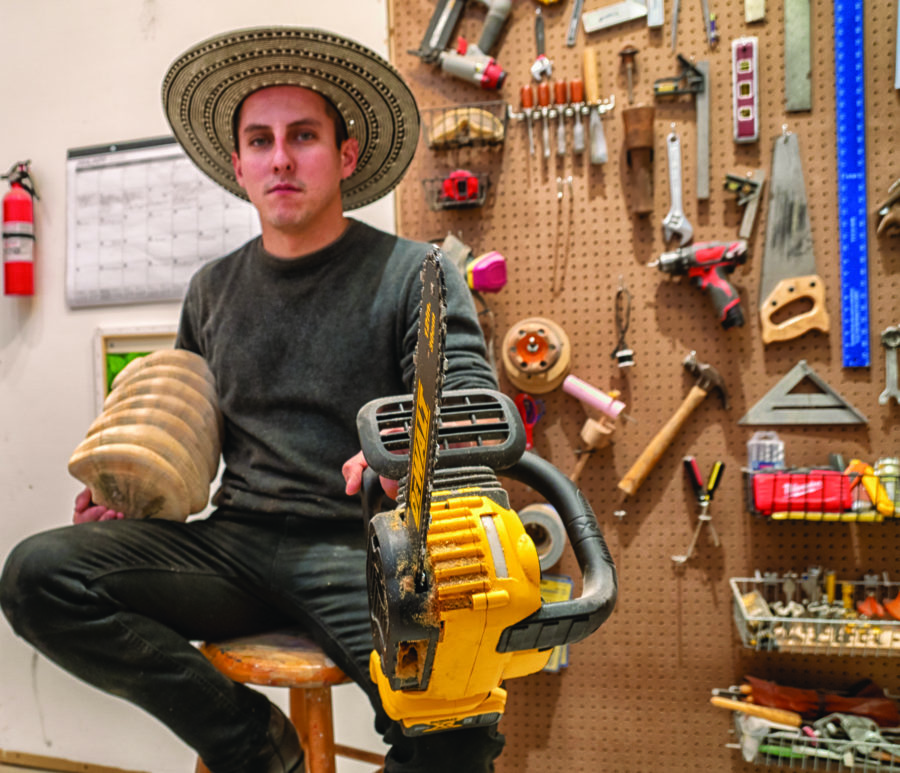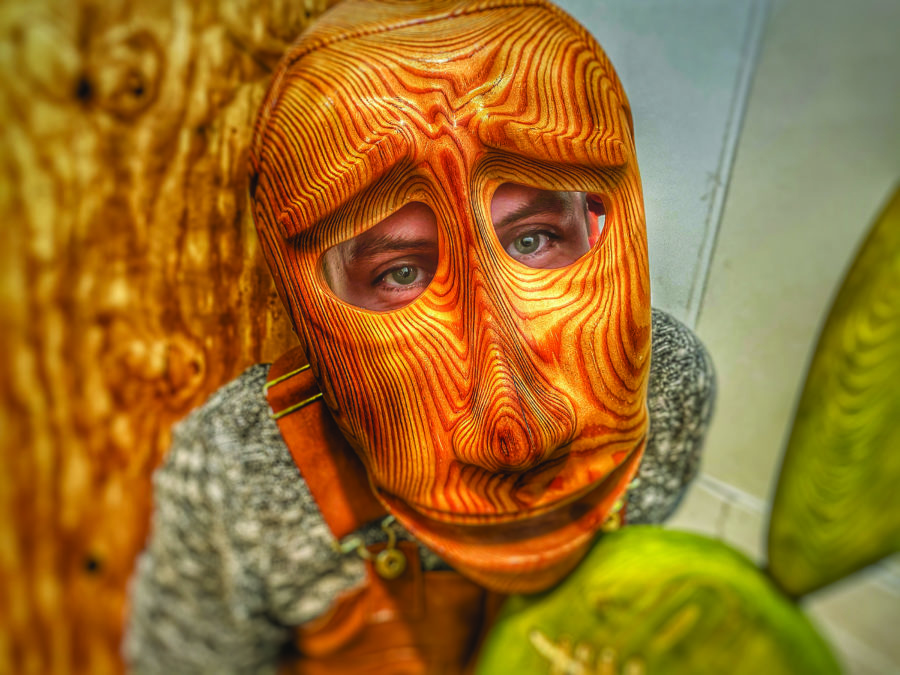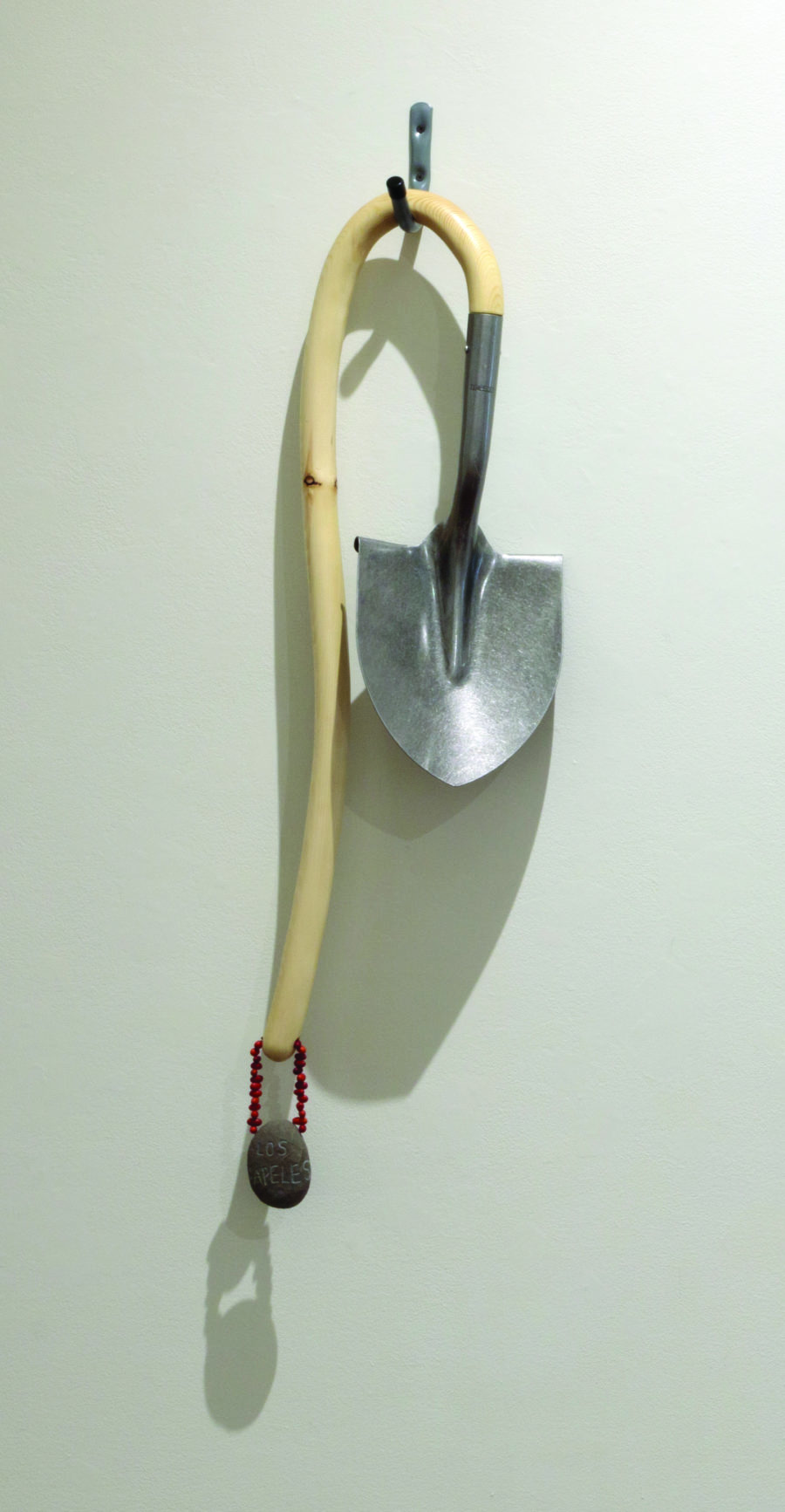In Raul De Lara’s studio at the Fine Arts Work Center in Provincetown, there’s a striking discrepancy between the maturity and polish of the sculpture on display and the youth of the artist standing beside them. Three new pieces, which will be revealed at the opening reception on Friday evening of De Lara’s show at FAWC, titled “Two self-portraits and one soft piece of wood,” command both the space and the viewer’s eye. Their impact is immediate and visceral.

De Lara, who was born in Mexico and immigrated to Texas with his family when he was 12, stands back to allow his artwork to speak for itself. He is wearing construction overalls, cowboy boots, and a welcoming smile that is at once confident and humble. The studio is filled with woodworking and construction tools, safety masks, and yet-to-be-transformed pieces of wood.
“These two are both self-portraits,” he says with a soft accent. De Lara asked that the Independent not publish photographs of the new works before their appearance at the show, which will be short-lived. “The morning after my show here,” he says, “Kevin [Fitchett, a FAWC writing fellow] will fly to Mexico City to install these sculptures at a group show opening there on Feb. 7 called ‘Geografía Relativa.’ ”
De Lara points to the larger of the two self-portraits, a standing cactus titled 28 years later, which incorporates one of the artist’s recently pulled wisdom teeth and a carved mask of his own facial features.
“My work is modular — this piece actually fits into a box small enough to transport on an airplane,” he says. The modularity is important, since “I myself cannot travel outside the U.S. because of my status as a DACA recipient” — that is, Deferred Action for Childhood Arrivals; he’s a Dreamer — “so I need to create my work so that it can ship easily and someone else can put it together.”
The second self-portrait, a cactus in the shape of a child’s school desk, is titled For being left-handed. “I’m shipping myself home in a box,” he says with a laugh. But there’s sadness in his voice.
De Lara, who got his M.F.A. last year from Virginia Commonwealth University, has not been back to Mexico in a long time. Mementos of his homeland surround him in the studio — traditional folkloric sculptures and masks sent to him by family members and friends; a bag of red tzite beans used in ancient rituals. He tells the story of his mother tying a red ribbon with a metal coin dangling from it around her belly during a lunar eclipse when she was pregnant with him, a ritual that promises the unborn baby a life of good fortune. Such narratives offer De Lara what he calls “energies,” from which his art draws force and inspiration.

Masks, De Lara says, such as the one in his self-portrait, are an example of a Mexican tradition that resonates deeply with his understanding of himself as an immigrant artist in the U.S. “There’s this idea behind the mask, that Mexican people never really show what’s within,” he said. “We’re showing instead this transient, very malleable self that never is.”
A sculpture in the shape of a bent wooden shovel droops from a hook on the wall. This piece, now showing at the FAWC fellows’ group show at the Provincetown Art Association and Museum, is one of a series of “tired tools.” De Lara explains: “I was thinking about not being allowed to set roots anywhere, about seeds that can’t grow, thinking about the actual weight of this piece and the gravity that pulls it downward, and of it being unused yet still tired. Tired from lack of use.” A handwritten tag dangles from the shovel’s handle, which reads Los papeles, or “the papers.”
The inclusion of language fragments in De Lara’s work is inspired by his time at the work center. “Language has always been an invisible space to me,” he says. “My bottleneck in graduate school was having to explain myself. But being around the poets and writers here has encouraged me to think about words and symbols as possible add-ons to my artworks, such as this tag.”

He points to the standing cactus self-portrait, onto which words, symbols, and drawings have been etched. In Mexico, there is a tradition of carving messages to loved ones into cacti, a practice that can be seen at the U.S.-Mexican border — refugees leave notes to those coming after them, such as pieces of advice, warnings of danger, or messages of hope.
“These cacti scars represent different memories and parts of my life from the moment I came to the U.S.,” De Lara says. “Until now, a lot of my work revolved around me being an ‘other’ in this country. With this opportunity to exhibit in Mexico City, I’ve been thinking about what I would like to send there as a fellow Mexican. I’ve been thinking about what binds you to a place, after such a long time of being away.”
Despite the weightiness of his subjects, De Lara insists that humor is essential to his art. “Humor has always helped me,” he says. “I use it as a tool and a driving force. I used to be tormented with the question of what the purpose is of making art now, with all the problems I have and all that is going on in the world. Is it the most responsible thing to be doing? I realized that part of what I hope to do with my work is lift spirits.”
De Lara’s own spirit has been lifted by the work center and the people he has met here.
“Living so close to my studio has given me the sense of days and weeks going by in just one moment,” he says. “This has allowed me to think my ideas through much further and make decisions about my work that I wouldn’t otherwise have felt so sure of. I’ve loved it completely.”
Crossover Dreams
The event: Opening reception of Raul De Lara exhibit
The time: Friday, Jan. 31, 6-8 p.m.
The place: Fine Arts Work Center, 24 Pearl St., Provincetown
The cost: Free



